词汇学复习要点总结
英语词汇学复习大纲整理
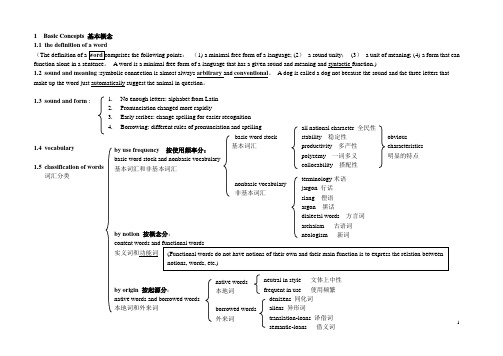
1 B a s i c C o n c e p t s 基本概念1.1 the definition of a word(: (1) a minimal free form of a language; (2) a sound unity ; (3) a unit of meaning; (4) a form that can function alone in a sentence 。
A word is a minimal free form of a language that has a given sound and meaning and syntactic function.)1.2 sound and meaning :symbolic connection is almost always arbitrary and conventional 。
A dog is called a dog not because the sound and the three letters thatmake up the word just automatically suggest the animal in question 。
1.3 sound and form : 1.4 vocabulary 1.5 classification of words 词汇分类 basic word stock 基本词汇nonbasic vocabulary 非基本词汇 by use frequency 按使用频率分: basic word stock and nonbasic vocabulary 基本词汇和非基本词汇by notion 按概念分:content words and functional words实义词和功能词by origin 按起源分: native words and borrowed words 本地词和外来词 all national character 全民性stability 稳定性 productivity 多产性 polysemy 一词多义 collocability 搭配性terminology 术语jargon 行话slang 俚语argon 黑话dialectal words 方言词archaism 古语词neologism 新词neutral in style 文体上中性frequent in use 使用频繁native words 本地词 borrowed words 外来词 denizens 同化词aliens 异形词translation-loans 译借词1. No enough letters: alphabet from Latin2. Pronunciation changed more rapidly3. Early scribes: change spelling for easier recognition4. Borrowing: different rules of pronunciation and spelling obviouscharacteristics明显的特点(Functional words do not have notions of their own and their main function is to express the relation betweennotions, words, etc.)2 D e v e l o p m e n tIt is assumed that the world has approximately 3, 000 (some put it 5, 000 ) languages , which can be grouped into roughly 300 language families on the basis of similarities in their basic word stock and grammar. 2。
英语词汇学知识点整理
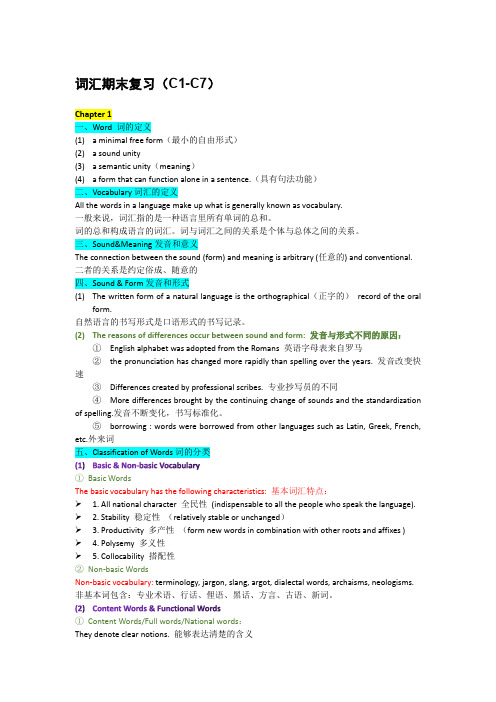
词汇期末复习(C1-C7)Chapter 1一、Word 词的定义(1) a minimal free form(最小的自由形式)(2) a sound unity(3) a semantic unity(meaning)(4) a form that can function alone in a sentence.(具有句法功能)二、Vocabulary词汇的定义All the words in a language make up what is generally known as vocabulary.一般来说,词汇指的是一种语言里所有单词的总和。
词的总和构成语言的词汇。
词与词汇之间的关系是个体与总体之间的关系。
三、Sound&Meaning发音和意义The connection between the sound (form) and meaning is arbitrary (任意的) and conventional. 二者的关系是约定俗成、随意的四、Sound & Form发音和形式(1)The written form of a natural language is the orthographical(正字的)record of the oralform.自然语言的书写形式是口语形式的书写记录。
(2)The reasons of differences occur between sound and form: 发音与形式不同的原因:①English alphabet was adopted from the Romans 英语字母表来自罗马②the pronunciation has changed more rapidly than spelling over the years. 发音改变快速③Differences created by professional scribes. 专业抄写员的不同④More differences brought by the continuing change of sounds and the standardization of spelling.发音不断变化,书写标准化。
词汇学复习重点
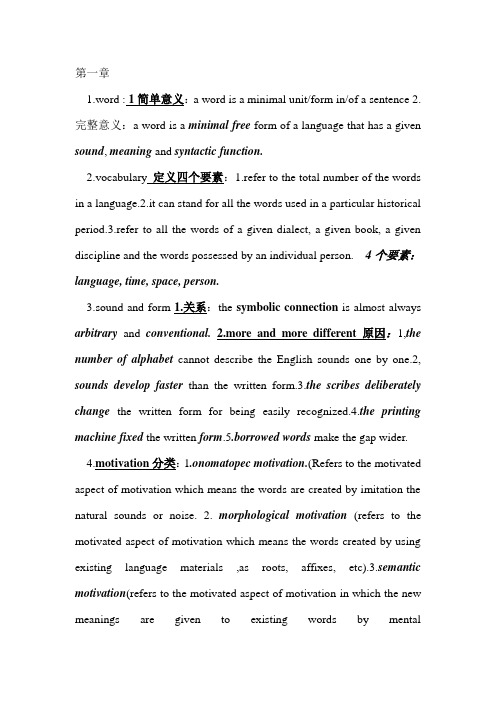
第一章1.word : 1简单意义:a word is a minimal unit/form in/of a sentence2.完整意义:a word is a minimal free form of a language that has a given sound, meaning and syntactic function.2.vocabulary定义四个要素:1.refer to the total number of the words in a language.2.it can stand for all the words used in a particular historical period.3.refer to all the words of a given dialect, a given book, a given discipline and the words possessed by an individual person. 4个要素:language, time, space, person.3.sound and form 1.关系:the symbolic connection is almost always arbitrary and conventional.2.more and more different 原因:1,the number of alphabet cannot describe the English sounds one by one.2, sounds develop faster than the written form.3.the scribes deliberately change the written form for being easily recognized.4.the printing machine fixed the written form.5.borrowed words make the gap wider. 4.motivation分类:1.onomatopec motivation.(Refers to the motivated aspect of motivation which means the words are created by imitation the natural sounds or noise. 2. morphological motivation(refers to the motivated aspect of motivation which means the words created by using existing language materials ,as roots, affixes, etc).3.semantic motivation(refers to the motivated aspect of motivation in which the new meanings are given to existing words by mentalassaiations.4.etymological motivation(refers to the motivated aspect of motivation by which the new meanings can directly tell the origin of the word.)4.word meaning 分类:4. “All national character”is the most important of all the features that may differentiate words of common use from all others.basic word stock基础词汇:1.all national character(全民性,必须有)2.stability 3.productivity 4.polysemy(一词多义)5.collocability(可搭配性) –5.Nonbasic vocabulary. 1。
词汇学复习
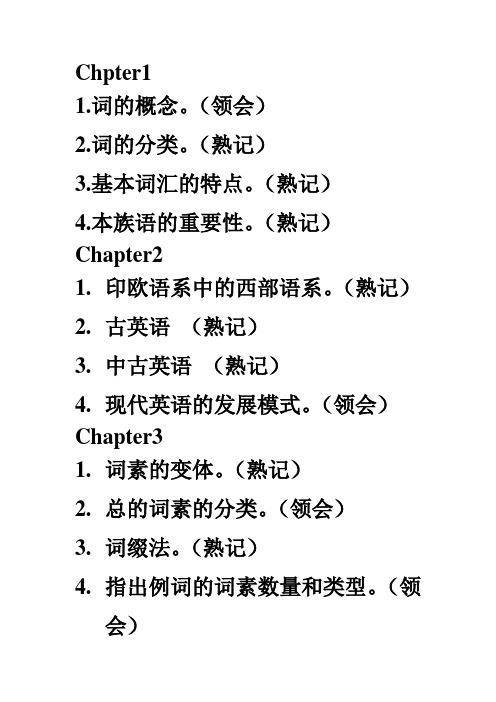
1.词的概念。
(领会)2.词的分类。
(熟记)3.基本词汇的特点。
(熟记)4.本族语的重要性。
(熟记)Chapter21.印欧语系中的西部语系。
(熟记)2.古英语(熟记)3.中古英语(熟记)4.现代英语的发展模式。
(领会)Chapter31.词素的变体。
(熟记)2.总的词素的分类。
(领会)3.词缀法。
(熟记)4.指出例词的词素数量和类型。
(领会)1.前缀的分类。
(熟记)2.转类法的类型。
(领会)3.部分转类法和完全转类法区别.(熟记)4.拼缀法类型。
(领会)5.截断法的概念。
(熟记)6.指出给的例词属于合成词,派生词,转类法的词,拼缀法,截断法,首字母缩略词,首字母拼音词,逆生法,来自于专有名词的词中的哪一个。
Chapter51.所指的概念。
(熟记)2.词的理据。
(熟记)3.理据的分类。
(领会)4.概念意义。
(熟记)5.褒义和贬义。
(领会)Chpter61.同义词的分类。
(熟记)2.反义词的分类。
(领会)3.上下义关系概念。
(熟记)4.语义场的作用。
(熟记)Chapter71.语义的扩大和缩小。
(领会)2.语义的降格。
(熟记)3.语境的作用。
(熟记)Chapter91.习语的特点。
(领会)2.习语的变异形式。
(领会)Chapter101. 单语词典和双语词典。
(熟记)。
词汇学复习资料

词汇学复习资料词汇学复习资料词汇学是语言学的一个重要分支,研究词汇的构成、分类和使用规律。
对于学习一门语言来说,掌握丰富的词汇是非常重要的。
在这篇文章中,我们将提供一些词汇学的复习资料,帮助读者巩固和扩展词汇量。
一、词汇的构成词汇是语言的基本单位,是由一个或多个音素组成的。
在不同的语言中,词汇的构成方式也有所不同。
例如,英语中的词汇主要由字母组成,而汉语中的词汇则由汉字组成。
1. 字母构词法英语中的词汇通常由字母组成,可以通过添加前缀、后缀和词根来构成新的词汇。
例如,单词“unhappiness”由前缀“un-”(表示否定)和词根“happy”组成。
2. 字形构词法汉语中的词汇由汉字组成,可以通过添加偏旁部首、衍生字和合成字来构成新的词汇。
例如,汉字“学”可以通过添加偏旁部首“子”来构成“字”,表示学习。
二、词汇的分类词汇可以按照不同的分类标准进行分类,例如按照词性、语义和用途等。
下面是一些常见的词汇分类。
1. 词性分类词汇可以分为名词、动词、形容词、副词、代词、介词、连词和感叹词等不同的词性。
名词用来表示人、事物或概念,动词用来表示动作或状态,形容词用来描述人或事物的特征,副词用来修饰动词、形容词或其他副词,代词用来代替名词,介词用来表示位置、时间或方式,连词用来连接词语或句子,感叹词用来表示强烈的情感。
2. 语义分类词汇可以按照词义的相似性进行分类。
例如,可以将名词按照人、动物、植物、物体、抽象概念等进行分类;将动词按照行为、状态、感觉、思维等进行分类;将形容词按照颜色、大小、形状、性质等进行分类。
3. 用途分类词汇可以按照在句子中的作用进行分类。
例如,可以将词汇分为实词和虚词。
实词包括名词、动词、形容词和副词,它们在句子中起到实际的意义;虚词包括代词、介词、连词和感叹词,它们在句子中起到连接或修饰的作用。
三、词汇的使用规律词汇的使用规律是指在特定语境中使用词汇的约束条件。
不同的语言和不同的语境中,词汇的使用规律也有所不同。
英语词汇学知识点归纳总结

英语词汇学知识点归纳总结
1.词汇分类:英语词汇可以分为实词和虚词两大类。
实词包括名词、
动词、形容词和副词,是能独立存在并具有词义的词类;虚词包括冠词、
介词、连词、代词和助词,是不能独立存在或不具有词义的词类。
2.词根与词缀:英语词汇中有很多词根和词缀,词根是词的核心部分,词缀是附加在词根上的,可以改变词的词义、词性或词形。
3.词义:英语词汇的词义可以通过定义、同义词、反义词、上下义词
等方式进行描述和解释。
词义可以有直观意义、引申意义和隐喻意义等。
4.词汇建构:英语词汇的建构可以通过合成、派生、转化、缩略等方
式进行。
合成是通过将两个或多个词根组合成一个新词,派生是通过添加
前缀或后缀来构成新词,转化是通过改变词的词类来构成新词,缩略是通
过省略部分词组或词根来构成新词。
5.词汇变化:英语词汇的变化形式包括时态、语态、人称、数和比较等。
词汇的变化形式可以通过词形变化、语法变化和语义变化等方式进行。
6.外借词:英语词汇中存在大量的外借词,这些词汇主要来自拉丁语、希腊语、法语、德语等其他语言。
外借词在英语中经过适当的拼写、读音
和意义调整后被接受和使用。
7.同源词:英语词汇中存在一些同源词,这些词源于同一词根或词源,并在语音、形态或词义上有一定的相似性。
了解同源词可以帮助理解和记
忆词汇。
8.词汇扩展:英语词汇在发展的过程中会发生扩展,即一个词从最初的特定意义扩展到更广泛的意义。
词汇扩展可以通过引申、转义、隐喻等方式进行。
这些是英语词汇学中的一些主要知识点,通过对这些知识点的学习和理解,可以更好地掌握和应用英语词汇。
词汇学知识点

词汇学知识点词汇学是语言学的一个重要分支,研究词汇的形态、构词法、含义、语法功能和使用规律等方面的知识。
词汇学知识点有助于我们更深入地了解语言的结构和规律,提高我们的语言运用能力和沟通能力。
下面将就词汇学的一些重要知识点进行详细介绍。
1. 词汇的分类根据词性的不同,词汇可以分为名词、动词、形容词、副词、代词、介词、连词和感叹词等不同种类。
名词是表示人、事、物、地点或抽象概念的词,如“学校”、“朋友”;动词是表示动作或状态的词,如“看”、“跑”;形容词是用来描述名词或代词的性质或特征的词,如“美丽”、“聪明”;副词是用来修饰动词、形容词或其他副词的词,如“很”、“非常”。
2. 词汇的构词法构词法是指词汇的构成规律和方法。
词汇可以通过加前缀、后缀、派生、复合、缩略、转化等方式形成新词。
比如,“美”+“丽”=“美丽”;“快”+“速”=“快速”;“快速”+“度”=“快速度”。
3. 词汇的含义词汇的含义是指词汇所代表的概念或事物。
词汇的含义可以根据词义的延伸、转义、比喻、象征等方式进行词义推论。
比如,“明星”原指天空中的星星,后引申为受人尊敬或崇拜的人。
4. 词汇的语法功能词汇在句子中具有不同的语法功能,如名词可以作主语、宾语、定语、表语等;动词可以表示主谓关系、宾语关系、状语关系等;形容词和副词可以修饰名词或代词等。
5. 词汇的使用规律词汇在语言运用中有一定的使用规律,比如词的搭配、语法环境、语言风格等。
正确地运用词汇有助于提高语言表达的准确性和丰富性。
通过以上对词汇学知识点的介绍,我们可以更系统地了解词汇在语言中的作用和重要性,进一步提高我们的语言水平和表达能力。
希望大家都能在学习词汇学知识点的过程中取得更好的成绩,展现自己在语言运用方面的能力。
【正文结束】。
词汇学知识点总结
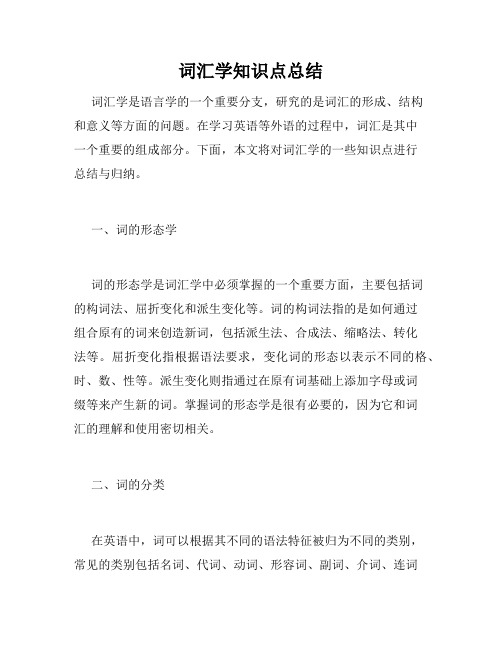
词汇学知识点总结词汇学是语言学的一个重要分支,研究的是词汇的形成、结构和意义等方面的问题。
在学习英语等外语的过程中,词汇是其中一个重要的组成部分。
下面,本文将对词汇学的一些知识点进行总结与归纳。
一、词的形态学词的形态学是词汇学中必须掌握的一个重要方面,主要包括词的构词法、屈折变化和派生变化等。
词的构词法指的是如何通过组合原有的词来创造新词,包括派生法、合成法、缩略法、转化法等。
屈折变化指根据语法要求,变化词的形态以表示不同的格、时、数、性等。
派生变化则指通过在原有词基础上添加字母或词缀等来产生新的词。
掌握词的形态学是很有必要的,因为它和词汇的理解和使用密切相关。
二、词的分类在英语中,词可以根据其不同的语法特征被归为不同的类别,常见的类别包括名词、代词、动词、形容词、副词、介词、连词和感叹词等。
不同的词在句子中扮演着不同的角色,掌握各类别之间的区别以及它们在句子中的作用,可以帮助我们更好地理解和表达语言。
三、词义词义是从语言学的角度定义词的意义,包括原义和引申义。
原义指的是一个词最基本的意思,而引申义则是在原义基础上经过延伸、扩展而得到的新意义。
同一个词的不同意义和语言环境等也会导致其含义的变化,例如“bank”既可以表示银行,也可以表示河岸等。
在学习外语的过程中,掌握词义是十分重要的。
四、词汇的学习方法词汇的学习是英语学习中最基础也最重要的部分之一,因此选择适合自己的学习方法对于提高词汇量、扩大词汇面积至关重要。
常用的学习方法包括反复背诵、积累单词簿、整理词根词缀、阅读和听力等。
在学习方法上,以选择适合自己和有用的方法为主,同时注意与语言运用的联系,不断地推广和实践。
五、词汇的应用掌握了词汇学的知识和学习方法后,其实就迈出了学习英语的第一步。
在实际运用中,如何运用得当也是至关重要的环节。
为了提高语言的流利度,需要在口语和书面语两个方面加强实践,增强实际运用能力。
另外,可以较晚多在社交网络等平台上与外国人联系,使用所学的词汇,将知识应用到实际交流之中,效果更佳。
英语词汇学知识点整理

词汇期末复习(C1-C7)Chapter 1一、Word 词的定义(1) a minimal free form(最小的自由形式)(2) a sound unity(3) a semantic unity(meaning)(4) a form that can function alone in a sentence.(具有句法功能)二、Vocabulary词汇的定义All the words in a language make up what is generally known as vocabulary.一般来说,词汇指的是一种语言里所有单词的总和。
词的总和构成语言的词汇。
词与词汇之间的关系是个体与总体之间的关系。
三、Sound&Meaning发音和意义The connection between the sound (form) and meaning is arbitrary (任意的) and conventional. 二者的关系是约定俗成、随意的四、Sound & Form发音和形式(1)The written form of a natural language is the orthographical(正字的)record of the oralform.自然语言的书写形式是口语形式的书写记录。
(2)The reasons of differences occur between sound and form: 发音与形式不同的原因:①English alphabet was adopted from the Romans 英语字母表来自罗马②the pronunciation has changed more rapidly than spelling over the years. 发音改变快速③Differences created by professional scribes. 专业抄写员的不同④More differences brought by the continuing change of sounds and the standardization of spelling.发音不断变化,书写标准化。
词汇学知识点总结

词汇学知识点总结词汇学是研究词汇的学科,它是语言学的一个重要分支,涉及了语言的构成、变化和使用等方面。
词汇学对于语言的理解和应用具有重要的意义,它不仅可以帮助我们更好地掌握语言知识,还可以帮助我们提高语言运用能力。
在这篇文章中,我们将对词汇学的知识点进行总结,帮助读者更好地理解和掌握这一学科。
一、词的定义和分类词是语言中的最小意义单位,是构成句子和表达意思的基本单位。
按照在句子中的功能和语法特征,词可以分为实词和虚词两大类。
实词包括名词、动词、形容词、副词等,它们能够表示具体的事物或抽象的概念;虚词包括代词、连词、介词、助词等,它们通常用来连接或修饰实词,没有明确的词义。
二、词汇的构成词汇的构成是指词的组成方式和形态特征。
在词汇的构成中,我们可以看到一些常见的构词法,如前缀、后缀、派生、合成、转化等。
通过这些构词法,我们可以对词汇进行灵活组合和创造,丰富语言的表达能力。
1.前缀前缀是指加在词根前面的一个字,可以改变词的词义或语法特征。
比如,“un-”表示否定,“re-”表示再次,“pre-”表示在前面等。
2.后缀后缀是指加在词根后面的一个字,同样可以改变词的词义或语法特征。
比如,“-ing”表示进行时,“-ful”表示充满的意思,“-ment”表示名词化等。
3.派生派生是指通过词根和词缀的组合来创造和衍生新的词。
比如,“happy”是一个形容词,通过加上“-ness”后缀就可以派生出名词“happiness”。
4.合成合成是指两个或多个词汇组合在一起,形成一个新的词。
比如,“blackboard”由“black”和“board”两个实词组合而成。
5.转化转化是指一个词汇的词类发生改变,但词形不变。
比如,“work”可以作为动词,也可以作为名词,它的词形都不发生变化。
词汇的构成方式是多种多样的,通过学习这些构词法,我们可以更好地理解和掌握词汇的形态特征,有助于提高我们的语言表达能力。
三、词汇的语义特征语义是指词汇所携带的意义,它是语言交流和理解的基础。
英语词汇学知识点归纳
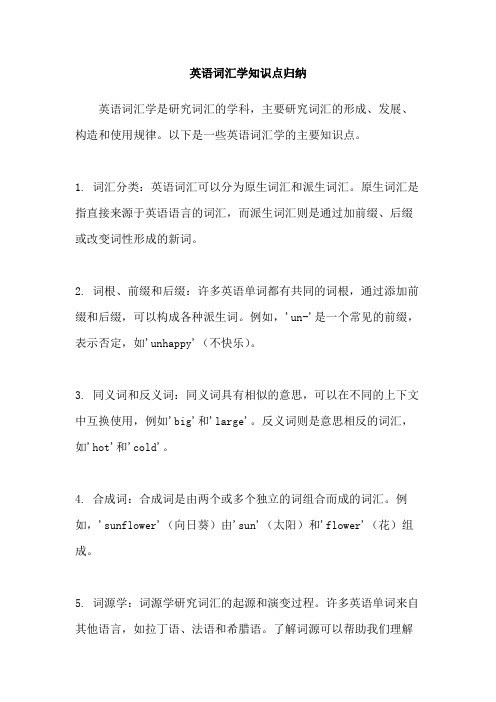
英语词汇学知识点归纳英语词汇学是研究词汇的学科,主要研究词汇的形成、发展、构造和使用规律。
以下是一些英语词汇学的主要知识点。
1. 词汇分类:英语词汇可以分为原生词汇和派生词汇。
原生词汇是指直接来源于英语语言的词汇,而派生词汇则是通过加前缀、后缀或改变词性形成的新词。
2. 词根、前缀和后缀:许多英语单词都有共同的词根,通过添加前缀和后缀,可以构成各种派生词。
例如,'un-'是一个常见的前缀,表示否定,如'unhappy'(不快乐)。
3. 同义词和反义词:同义词具有相似的意思,可以在不同的上下文中互换使用,例如'big'和'large'。
反义词则是意思相反的词汇,如'hot'和'cold'。
4. 合成词:合成词是由两个或多个独立的词组合而成的词汇。
例如,'sunflower'(向日葵)由'sun'(太阳)和'flower'(花)组成。
5. 词源学:词源学研究词汇的起源和演变过程。
许多英语单词来自其他语言,如拉丁语、法语和希腊语。
了解词源可以帮助我们理解词汇的含义和用法。
6. 词义的变化:词汇的意义会随时间和语境的变化而变化。
一些词汇可能会产生新的意义或失去原有的意义。
例如,'mouse'(老鼠)最初是指一种小动物,现在也可以指计算机的输入设备。
7. 词汇的语法功能:词汇在句子中扮演不同的语法角色,如名词、动词、形容词等。
了解词汇的语法功能可以帮助我们正确使用它们。
8. 语义关系:词汇之间存在各种语义关系,如同义关系、反义关系、上下位关系等。
了解这些关系可以帮助我们扩展词汇量,提高语言表达能力。
9. 词汇的习得和记忆:习得和记忆词汇是学习英语的重要一部分。
采用合适的记忆方法,如使用词汇卡片、词汇表等,可以帮助我们更好地掌握词汇。
以上是英语词汇学的一些主要知识点。
英语词汇学知识点归纳
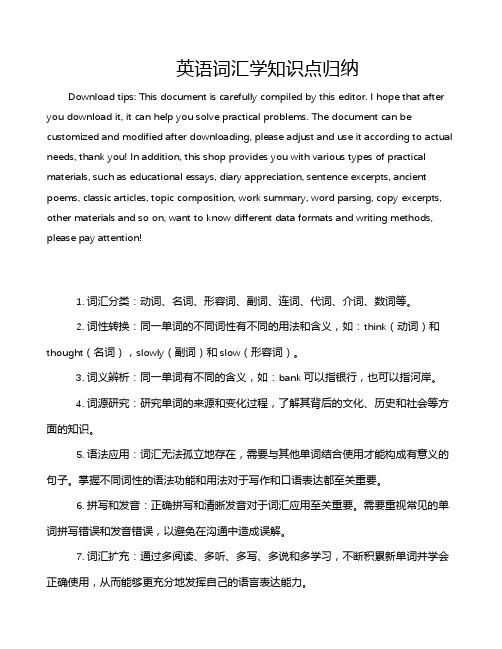
英语词汇学知识点归纳Download tips: This document is carefully compiled by this editor. I hope that after you download it, it can help you solve practical problems. The document can be customized and modified after downloading, please adjust and use it according to actual needs, thank you! In addition, this shop provides you with various types of practical materials, such as educational essays, diary appreciation, sentence excerpts, ancient poems, classic articles, topic composition, work summary, word parsing, copy excerpts, other materials and so on, want to know different data formats and writing methods, please pay attention!1. 词汇分类:动词、名词、形容词、副词、连词、代词、介词、数词等。
2. 词性转换:同一单词的不同词性有不同的用法和含义,如:think(动词)和thought(名词),slowly(副词)和slow(形容词)。
3. 词义辨析:同一单词有不同的含义,如:bank可以指银行,也可以指河岸。
4. 词源研究:研究单词的来源和变化过程,了解其背后的文化、历史和社会等方面的知识。
词汇学复习重点(精心挑选整理过的)

Motivation of words分类:onomatopoeic motivation, morphological motivation, semantic motivation, etymological motivation. Types of meaning: grammatical ~ & lexical ~; conceptual ~& associative ~(connotative~, stylistic~, affective ~, collocative ~,)Primary meaning is the only meaning that a word had when it was first created. Derived meanings are the meanings that a word gets from the primary meaning at different stages of its development in the course of time.同义关系Synonyms are words which share the same or nearly the same meaning with each other but different in sound and spelling. There are absolute synonyms and relative synonyms which result from borrowing, dialects and regional English, figurative and euphemistic use of words, coincidence with idiomatic expressions. There exists the difference between or among synonyms in terms of their denotation, connotation or application. Absolute synonyms or complete synonyms are words which are identical in meaning in all its aspects. Relative synonyms or near-synonyms are similar or nearly the same in denotation, but embrace different shades of meaning or different degrees of a given quality.3.Sources of Synonyms 1) Borrowing 2)Dialects and regional English 3) Figurative and euphemistic use of words 4) Coincidence with idiomatic expressions4.What are the characteristics of antonyms?1) Antonyms are classified on the basis of semantic opposition 2) A word which has more than one meaning can have more than one antonym. 3) Antonyms differ in semantic inclusion. 4) Contrary terms are gradable antonyms, differing in degree of intenisty, so each has its own corresponding opposite.5.同形同音异义关系Homonymy is one of the features of words that a word is different in meaning from another, but either identical both in sound and spelling or identical only in sound or spelling with the other Homonyms generally fall into three classes: perfect homonyms (same name); homographs (same spelling) and homophones (some sound). Perfect homonyms are those words identical both in sound and spelling, but different in meaning. Homophones refer to the words identical only in sound but different in spelling and meaning6.上下义关系:Hyponymy deals with the relationship of semantic inclusion. That is, the meaning of a more specific word is included in that of another more general word. Superordinates refer to some general words; subordinates denote those more specific words. Hyponymy can be described in terms of tree-like graphs, with higher-order superordinates above the lower subordinates. But their status either as superordinate or subordinate is relative to other terms. For example, horse, dog, pig are subordinates in relation to animal, but superordinates of mare, hound and boar, Animal itself becomesa subordinate of creature. And creature in turn becomes7.词义变化的种类There are five types of meaning, changes: extension, narrowing, degradation, elevation, and transfer among which extension and narrowing are the most common. Changes in meaning can be accounted for from extra-linguistic factors (historical reason, class reason, and psychological reason) and intra-linguistic factors (shortening, the influx of borrowing, and analogy).8.词义的扩大Extension is a process by which a word with a specialized sense is generalized to covera broader or less9.Definite concept. Compare the following;词义的缩小Narrowing is a process by which a word of wider meaning acquires a specialized sense;词义的升华Elevation is a process by which a word moves from a derogatory or neutral sense to a neutral and/or appreciative sense;词义的降格Degradation is a process by which a word of reputation slides into a pejorative use,;词义的转移Transfer is a process by which a word denoting one thing changes to refer to a different but related thing. Paper serves as an example. This word formerly denoted an African plant papyrus, which was once used to make paper. In modern times, paper is made from rags, wood, straw and the like, but theproduct has retained the same name. There is associated transfer. There are other kinds of transfer, such as, concrete to abstract, abstract to concrete and transfer of sensation.10.语境的种类:非语言语境。
自考2英语词汇学考试重点精华整理

自考2英语词汇学考试重点精华整理一、词汇学概述1、语言与词汇的关系:语言是词汇和语法规则的总和,而词汇则是语言中最基本的元素。
2、词汇学的定义:词汇学是研究语言的词汇以及词汇的起源、演变、语义和语用等方面的学科。
3、词汇学的研究对象:主要包括词汇的起源、演变过程、语义变化、文化背景等。
二、英语词汇的历史演变1、英语的起源:英语起源于古代日耳曼语,经过长时间的演变和发展,形成了今天的英语。
2、英语词汇的演变:英语词汇经历了许多变化,包括词义的变化、词形的变化、外来词的引入等。
3、英语词汇的分类:英语词汇可以根据其来源、语义、语法等方面进行分类。
三、英语词汇的语义关系1、同义词与反义词:同义词是指具有相同或相似意义的词汇,而反义词则是指具有相反意义的词汇。
2、上下义词与下义词:上下义词是指在一个词汇的语义场中,一个词可以表示另一个词的上层概念或下层概念。
3、词汇的文化意义:词汇的文化意义是指词汇在特定文化背景中所具有的意义。
四、英语词汇的记忆与运用1、记忆策略:记忆策略是指通过一定的方法来提高记忆效率,包括联想记忆、语境记忆等。
2、运用技巧:运用技巧是指在使用词汇时需要注意的事项,包括语用、语法等方面。
3、常见错误分析:常见错误分析是指对学生在使用词汇时容易犯的错误进行分析和纠正。
五、英语词汇的学习方法与技巧1、学习策略:学习策略是指通过一定的方法来提高学习效率,包括制定学习计划、使用学习工具等。
2、学习技巧:学习技巧是指在学习过程中需要注意的事项,包括如何集中注意力、如何提高学习效率等。
3、学习资源:学习资源是指在学习过程中可以使用的各种资源,包括书籍、网站、课程等。
词汇学是语言学的一个分支,主要研究词汇的起源、发展、变化和用法。
它涉及对单词的音、形、义、语法特征和语用意义等方面的研究。
词汇学有一些基本概念,包括词、词汇、词素、词义、语境等。
词是语言中最小的、可以独立使用的意义单位,词汇是语言中所有词的总和,词素是构成词的要素,词义是词的含义,语境是指词所处的语言环境。
《英语词汇学》知识点归纳
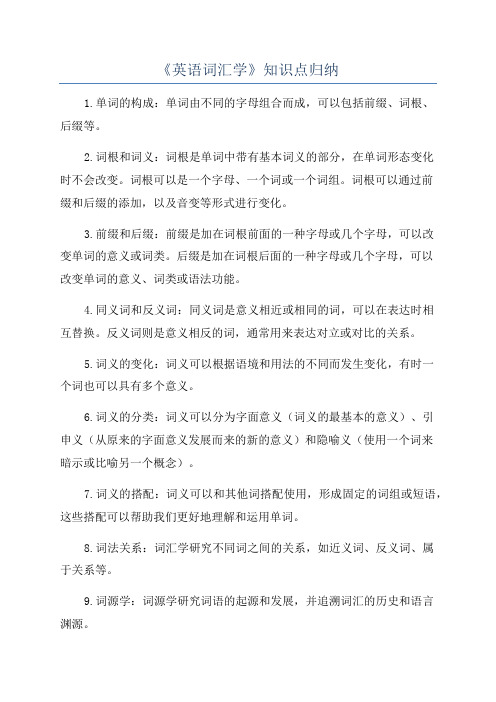
《英语词汇学》知识点归纳
1.单词的构成:单词由不同的字母组合而成,可以包括前缀、词根、
后缀等。
2.词根和词义:词根是单词中带有基本词义的部分,在单词形态变化
时不会改变。
词根可以是一个字母、一个词或一个词组。
词根可以通过前
缀和后缀的添加,以及音变等形式进行变化。
3.前缀和后缀:前缀是加在词根前面的一种字母或几个字母,可以改
变单词的意义或词类。
后缀是加在词根后面的一种字母或几个字母,可以
改变单词的意义、词类或语法功能。
4.同义词和反义词:同义词是意义相近或相同的词,可以在表达时相
互替换。
反义词则是意义相反的词,通常用来表达对立或对比的关系。
5.词义的变化:词义可以根据语境和用法的不同而发生变化,有时一
个词也可以具有多个意义。
6.词义的分类:词义可以分为字面意义(词义的最基本的意义)、引
申义(从原来的字面意义发展而来的新的意义)和隐喻义(使用一个词来
暗示或比喻另一个概念)。
7.词义的搭配:词义可以和其他词搭配使用,形成固定的词组或短语,这些搭配可以帮助我们更好地理解和运用单词。
8.词法关系:词汇学研究不同词之间的关系,如近义词、反义词、属
于关系等。
9.词源学:词源学研究词语的起源和发展,并追溯词汇的历史和语言
渊源。
10.词汇扩充:词汇学研究如何通过学习和运用词汇扩充词汇量,如学习词根、前缀和后缀的意义和用法,以及拆解和分析复杂单词的方法。
词汇学第二章知识点总结
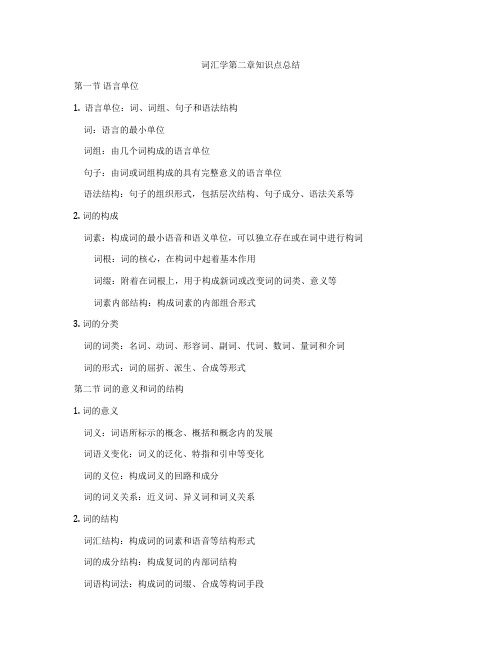
词汇学第二章知识点总结第一节语言单位1. 语言单位:词、词组、句子和语法结构词:语言的最小单位词组:由几个词构成的语言单位句子:由词或词组构成的具有完整意义的语言单位语法结构:句子的组织形式,包括层次结构、句子成分、语法关系等2. 词的构成词素:构成词的最小语音和语义单位,可以独立存在或在词中进行构词词根:词的核心,在构词中起着基本作用词缀:附着在词根上,用于构成新词或改变词的词类、意义等词素内部结构:构成词素的内部组合形式3. 词的分类词的词类:名词、动词、形容词、副词、代词、数词、量词和介词词的形式:词的屈折、派生、合成等形式第二节词的意义和词的结构1. 词的意义词义:词语所标示的概念、概括和概念内的发展词语义变化:词义的泛化、特指和引申等变化词的义位:构成词义的回路和成分词的词义关系:近义词、异义词和词义关系2. 词的结构词汇结构:构成词的词素和语音等结构形式词的成分结构:构成复词的内部词结构词语构词法:构成词的词缀、合成等构词手段第三节词义关系和词义演变1. 词义关系上下位关系:词义之间的概括和被概括关系同类词关系:在特定范畴或范围内词义之间的同类关系词语义联系:在使用中词义之间的联系和联系表达2. 词义演变词义的演变:在历史发展和使用中词义的变化和扩展词义变化类型:词义的泛化、转移、借代、内涵、外延等变化类型词义变化因素:历史、社会、文化、语言接触等诸多因素第四节词在句法中的功能和语意1. 词的句法功能词的句法功能:在句中词所承担的成分和功能句法结构:构成句子的各种句法成分的组织形式2. 词的语义特征词的语义特征:词的语义属性和特别意义词的意义转换:词义在句法中的隐喻、比喻、借代和辞让等转换方式词义在句法中的表现:词义在句中所呈现的语义特征和语义表达第五节词汇的心理基础1. 词汇的心理组织词的心理存储:词的存储方式和内部心理结构词汇记忆:词的认知和记忆方式及其规律词的心理连接:词之间在心理中的联结和联系2. 词汇的心理活动词的心理组织:词的认知、思维、理解、表达等心理活动词的心理过程:词的产生、使用、决策、回忆、判断等心理过程第六节词汇习得和使用1. 词汇的习得语言习得:语言学习者获取和掌握词汇的过程词汇习得理论:第一语言习得和第二语言习得的理论及其实践词汇习得策略:词汇习得过程中的学习策略和方法2. 词汇的使用词汇的应用范畴:词汇在语言和交际中的各种应用范畴和方式词汇的使用规律:词汇在使用中的频率、变化、地域差异等规律词汇的使用技巧:词汇使用中的技巧、技能、风格等第七节词汇学的理论和研究方法1. 词汇学的理论词汇研究理论:词汇研究的主流理论和方法词汇学派别:各种词汇学派别对词汇研究的探索和发展词汇发展趋势:未来词汇研究的方向、趋势、发展和应用2. 词汇学的研究方法词汇的研究方法:词汇的描述、分析、解释的研究方法和手段词汇的实证研究:词汇在使用中的实证研究方法和技术词汇的应用研究:词汇在语言学、教育学、心理学等领域的应用研究以上是词汇学第二章的知识点总结。
英语词汇学总结复习资料
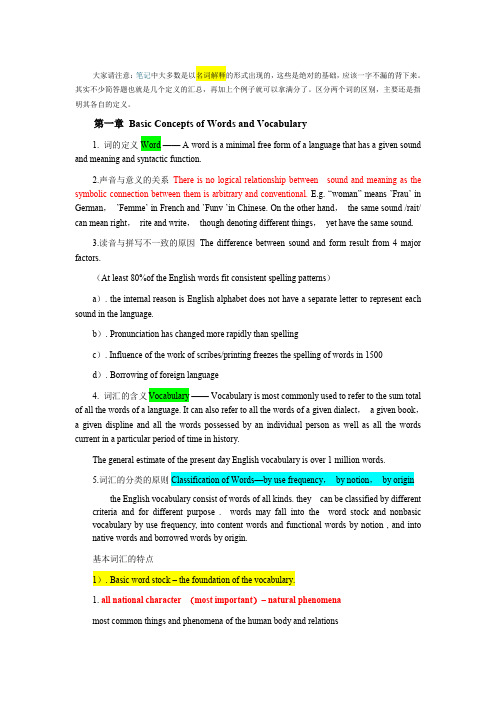
大家请注意:笔记中大多数是以名词解释的形式出现的,这些是绝对的基础,应该一字不漏的背下来。
其实不少简答题也就是几个定义的汇总,再加上个例子就可以拿满分了。
区分两个词的区别,主要还是指明其各自的定义。
第一章Basic Concepts of Words and Vocabulary1. 词的定义Word —— A word is a minimal free form of a language that has a given sound and meaning and syntactic function.2.声音与意义的关系There is no logical relationship between sound and meaning as the symbolic connection between them is arbitrary and conventional.E.g. “woman” means ’Frau’ in German,’Femme’ in French and ’Funv ’in Chinese. On the other hand,the same sound /rait/ can mean right,rite and write,though denoting different things,yet have the same sound.3.读音与拼写不一致的原因The difference between sound and form result from 4 major factors.(At least 80%of the English words fit consistent spelling patterns)a). the internal reason is English alphabet does not have a separate letter to represent each sound in the language.b). Pronunciation has changed more rapidly than spellingc). Influence of the work of scribes/printing freezes the spelling of words in 1500d). Borrowing of foreign language4. 词汇的含义Vocabulary —— Vocabulary is most commonly used to refer to the sum total of all the words of a language. It can also refer to all the words of a given dialect,a given book,a given displine and all the words possessed by an individual person as well as all the words current in a particular period of time in history.The general estimate of the present day English vocabulary is over 1 million words.5.词汇的分类的原则Classification of Words—by use frequency,by notion,by originthe English vocabulary consist of words of all kinds. they can be classified by different criteria and for different purpose . words may fall into the word stock and nonbasic vocabulary by use frequency, into content words and functional words by notion , and into native words and borrowed words by origin.基本词汇的特点1). Basic word stock – the foundation of the vocabulary.1.all national character (most important)– natural phenomenamost common things and phenomena of the human body and relationsworld around us names of plants and animals action,size,domain,state numerals,pronouns,prep. ,conj.2. stability– they donate the commonest thing necessary to life,they are like to remain unchanged. Only relative,some are undergoing some changes. But the change is slow.e.g. arrow,bow,chariot,knight – past electricity,machine,car,plane ——now3.productivity– they are mostly root words or monosyllabic words,they can form new words with other roots and affixes.e.g. foot – football,footage,footpath,footer4.polysemy – often possess more than one meaning. Become polysemous.e.g. take to move or carry from one place to another to remove5.collocability– quite a number of set expressions,idiomatic usages,proverbial saying and others基本词汇在英语中的地位和重要性The basic word stock is the foundation of the vocabulary accumulated over centuries and forms the common core of the language .though words of the basic word stock constitute a small percentage of the English vocabulary ,yet it is the most important part of it .e.g. heart – a change of heart, a heart of goldNon-basic vocabulary ——(例子)1. terminology –technical terms used in particular disciplines and academic areas as in medicinephotoscanning,hepatitis,indigestion,penicillin,algebra,trigonometry,calculus2. jargon– specialized vocabulary in certain professions.Bottom line,ballpark figures,bargaining chips,hold him back,hold him in,paranoid3. slang—— substandard words often used in informal occasionsdough and bread,grass and pot,beaver,smoky,bear,catch,holler,Roger,X-rays,Certain words are labeled slang because of their usage.4. argot – words used by sub-cultured groupscan-opener,dip,persuader cant,jargon ,argot are associated with,or most available to,specific groups of the population.5. dialectal words– only by speakers of the dialectbeauty,chook,cocky,station,auld,build,coo,hame,lough,bog6. archaisms – words no longer in common use or restricted in use. In older poems,legal document and religious writing or speech.7. neologism– newly created words with new meaning e.g. microelectronics,futurology,AIDS,internet,E-mailold meaning acquired new meaning e.g. mouse,monitor2). Content word (notional word)– denote clear notions.Functional word (empty word,form word)– do not have notions of their own,express the relation between notions,words and sentences.a. Content words constitute the main body of the English vocabulary are numerous.Functional words are in a small number.b. Content words are growing.Functional words remain stable.c. Functional words do far more work of expression than content words.3). Native words –are words brought to Britain in the 15 century by the German tribes. Ango-Saxon Words,50,000-60,000What is true of the basic word stock is also true of native world. More are1. neutral in style (not stylistical specific )2. 2.frequent in use (in academic fields and science French,Latin or Greek are used)(usage 70-90%)Borrowed words (loan words,borrowing)– words taken over from foreign language. 80%本族语词在英语中的地位和重要性Native words form the mainstream of the basic word stock and stand at the core of the language .therefore , what is true of the basic word stock is also true of native words.According to the degree of assimilation and manner of borrowing,we can bring the loan words under 4 classes.1.Denizen s– words borrowed early and now are well assimilated into English language.e.g. port from portus(L)shift,change,shirt,pork cup from cuppa(L)2.Aliens– retained their original pronunciation and spellinge.g. décor(F)blitzkreeg(G)emir,intermez,rowtow,bazaar,rajar,status quo3.translation loans– formed from the existing material in the English language but modeled on the patterns taken from another language.1). Word translated according to the meaninge.g. mother tough from lingua maternal(L)black humor from humor noir long time no see,surplus value,master piece2). Words translated according to the sounde.g. kulak from kyrak(Russ)lama from lama(Tib)ketchup tea4. Semantic loans– their meaning are borrowed from another languagee.g. stupid old dump new sassy dream old joy and peace pioneer old explorer/person doing pioneering work new a member of the young pioneer fresh old impertinent,sassy,cheeky第二章The Development of the English1、Indo-European language family (Europe,the Near East,India)It can be grouped into an Eastern set :Balto –Slavic 、Indo-Iranian、Armenian and Albanian; a Western set: Celtic、Italic 、Hellenic、GermanicIn the Eastern set , Armenian and Albanian are each the only modern language respectively,the Balto –Slavic comprises such modern language such as Prussian、Lithuanian、Polish、Czech、Bulgarian、Slovenian、Russian. In the Indo-Iranian we have Persian, Bengali, Hindi, Romany, the last three of which are derived from the dead language Sanskrit.In the Western set, Greek is the modern language derived from Hellenic. In the Celtic,we find Scottish, Irish,Welsh, Breton. the five Romance language ,namely, Portuguese,Spanish, French, Italian, Roumanian all belong to the Italic through an intermediate language called Latin. The Germanic family consist of the four Northern European language :Norwegian, Icelandic, Danish and Swedish, which are generally known as Scandinavian languages. Then there is German, Dutch, Flemish and English.2、History (时间,历史事件,特征)1)Old English (450-1150)totally 50,000-60,000 wordsThe 1st people known to inhabit England were Celts,the language was Celtic.The second language was the Latin of the Roman Legions. The Germanic tribes called angles,Saxons and Jutes and their language,Anglo-Saxon dominated and blotted out the Celtic. Now people refer to Anglo-Saxon as old English. At the end of 6th century,the introduction of Christianity has a great impact on the English vocabulary. The common practice was to create new words bycombining two native words. In the 9th century,many Scandinavian words came into English. At least 900 words of Scandinavian are in modern English,our daily life and speech.特点:highly inflected language///complex endings or vowel changes (full ending)2)Middle English (1150-1500)English,Latin,FrenchUntil 1066,although there were borrowings from Latin,the influence on English was mainly Germanic. But the Norman Conquest started a continual flow of French words into English.By the end of the 13th century,English gradually come back into public areas.Between 1250 and 150 about 9000 words of French origin pouered into English. 75% of them are till in use today.As many as 2500 words of Dutch origin come into English.特点:fewer inflections leveled ending3)Modern English (1500-up to now)early modern English (1500-1700)late modern English(1700-up to now)The Renaissance(the early period),Latin and Greek were recognized as the languages of the West ern world’s great literary heritage.From the 1500’s through the 1700’s ,many writers experimented with words. Over 10000 new words entered the English language .many of these were taken from Latin and Greek .The Industrial Revolution was in the mid-17 century. With the growth of colonization,British tentacles began a stretching out of to every corner of the globe,thus enabling English to absorb words from all major languages of the world.After World War II,many new words have been created to express new ideas,inventions and scientific achievements.More words are created by means of word-formation.thousands and thousands of new words have been entered to express new ideas inventions,and scientific achievements.more words are created by means of word-formation.in modern English,word endings were mostly lost with just a few exceptions English has evolved from a synthetic language to the present analytic language.science and technology terms make up about 45% of new words. words associated with life-style constitute of 24% and social and economic terms amount to over 10% .mention should be made of an opposite process of development i.e. old words falling out if use.特点:ending are almost lost.3. Three main sources new words当代英语词汇发展的现状New words sweep in at a rate much faster than at any other historical period of time .词汇发展的主要原因1).The rapid development of modern science and technology2).Social: economic and political changes3).The influence of other cultures and languages4. Three modes of vocabulary development(英语发展的三个主要方式:创造新词、旧词新意、借用外来语词)1. Creation – the formation of new words by using the existing materials,namely roots,affixes and other elements. (This is the most important way of vocabulary expansion.)2. Semantic change - an old form which take on a new meaning to meet the new need.3. Borrowing – to take in words from other languages.(played a vital role in the development of vocabulary , particularly in earlier times)4. (Reviving archaic or obsolete)French 30%,Latin 8%,Japanese Italian 7%,Spanish 6%,German Greek 5%,Russian Yiddish 4%第三章Word Formation*1. Morpheme(词素) ——A morpheme is the smallest meaningful unit of a language. (The smallest functional unit in the composition of words.)*2.Morph—— A morpheme must be realized by discrete units. These actual spoken minimal carriers of meaning are morphs.3.Monomorphenic words– morphemes are realized by single morphs.4.Allomorph(词素变体)——Some morphemes are realized by more than one morph according to their position. Such alternative morphs are allomorphemes. E.g. the morpheme of plurality (-s)has a number if allomorphemes in different sound context,e.g. in cats/s/,in bags/z/,in matches/iz/.5. Free morphemes or Free root —— The morphemes have complete meaning and van be used as free grammatical units in sentences,e.g. cat,walk. They are identical with root words. morphemes which are independent of other morphemes are considered to be free.6.Bound Morphemes——The morphemes cannot occur as separate words. They are bound to other morphemes to form words,e.g. recollection (re+collect+ion)collect – free morpheme re-and –ion are bound morphemes. (include bound root and affix)Bound morphemes are found in derived words.7.Bound root ——A bound root is that part of the word that carries the fundamental meaning just like a free root. Unlike a free root,it is a bound form and has to combine with other morphemes to make words. Take -dict- for example:it conveys the meaning of “say or speak” as a Latin root,but not as a word. With the prefix pre-(=before)we obtain the verb predict meaning “tell beforehand”。
词汇学期末复习各章知识点
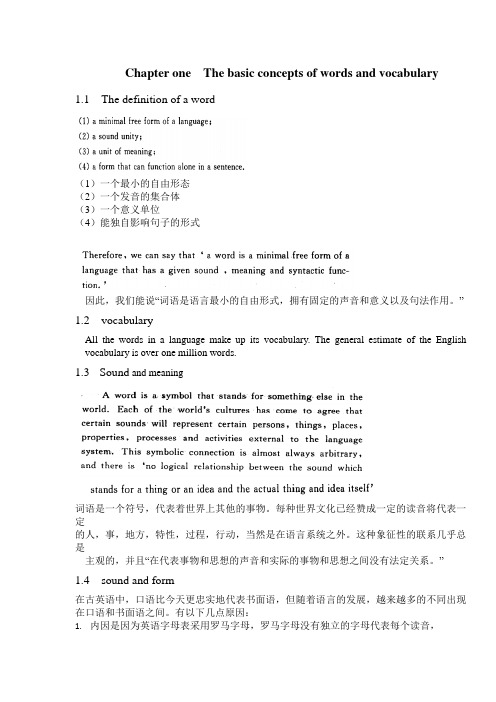
Chapter one The basic concepts of words and vocabulary1.1 The definition of a word(1)一个最小的自由形态(2)一个发音的集合体(3)一个意义单位(4)能独自影响句子的形式因此,我们能说“词语是语言最小的自由形式,拥有固定的声音和意义以及句法作用。
”1.2 vocabularyAll the words in a language make up its vocabulary. The general estimate of the English vocabulary is over one million words.1.3Sound and meaning词语是一个符号,代表着世界上其他的事物。
每种世界文化已经赞成一定的读音将代表一定的人,事,地方,特性,过程,行动,当然是在语言系统之外。
这种象征性的联系几乎总是主观的,并且“在代表事物和思想的声音和实际的事物和思想之间没有法定关系。
”1.4 sound and form在古英语中,口语比今天更忠实地代表书面语,但随着语言的发展,越来越多的不同出现在口语和书面语之间。
有以下几点原因:1.内因是因为英语字母表采用罗马字母,罗马字母没有独立的字母代表每个读音,因此一些字母代表两个读音或者组合在一起发音。
2.另一个原因是发音比拼写的变化快,在一些时候还拉开了距离。
在最近五百年里,尽管口语发音已经出现了显著的变化,却没有相应的拼写变化。
Another reason for this is that the pronunciation has changed more rapidly than spelling over the years, and in some cases the two have drawn far apart.3.第三个原因是一些早期的书写员发明了一些不同Those scribes had made some change to the word spelling4.到1500年年末,印刷已经变得非常普及。
语文词汇学知识点梳理
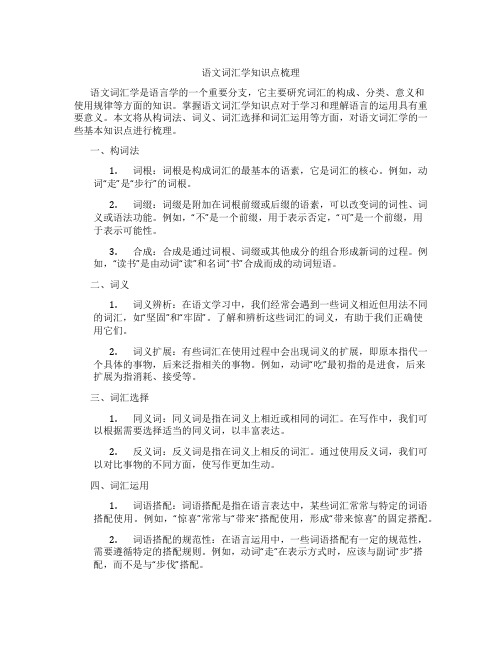
语文词汇学知识点梳理语文词汇学是语言学的一个重要分支,它主要研究词汇的构成、分类、意义和使用规律等方面的知识。
掌握语文词汇学知识点对于学习和理解语言的运用具有重要意义。
本文将从构词法、词义、词汇选择和词汇运用等方面,对语文词汇学的一些基本知识点进行梳理。
一、构词法1.词根:词根是构成词汇的最基本的语素,它是词汇的核心。
例如,动词“走”是“步行”的词根。
2.词缀:词缀是附加在词根前缀或后缀的语素,可以改变词的词性、词义或语法功能。
例如,“不”是一个前缀,用于表示否定,“可”是一个前缀,用于表示可能性。
3.合成:合成是通过词根、词缀或其他成分的组合形成新词的过程。
例如,“读书”是由动词“读”和名词“书”合成而成的动词短语。
二、词义1.词义辨析:在语文学习中,我们经常会遇到一些词义相近但用法不同的词汇,如“坚固”和“牢固”。
了解和辨析这些词汇的词义,有助于我们正确使用它们。
2.词义扩展:有些词汇在使用过程中会出现词义的扩展,即原本指代一个具体的事物,后来泛指相关的事物。
例如,动词“吃”最初指的是进食,后来扩展为指消耗、接受等。
三、词汇选择1.同义词:同义词是指在词义上相近或相同的词汇。
在写作中,我们可以根据需要选择适当的同义词,以丰富表达。
2.反义词:反义词是指在词义上相反的词汇。
通过使用反义词,我们可以对比事物的不同方面,使写作更加生动。
四、词汇运用1.词语搭配:词语搭配是指在语言表达中,某些词汇常常与特定的词语搭配使用。
例如,“惊喜”常常与“带来”搭配使用,形成“带来惊喜”的固定搭配。
2.词语搭配的规范性:在语言运用中,一些词语搭配有一定的规范性,需要遵循特定的搭配规则。
例如,动词“走”在表示方式时,应该与副词“步”搭配,而不是与“步伐”搭配。
以上是语文词汇学的一些基本知识点梳理。
通过掌握这些知识,我们可以更好地理解和运用词汇,提高语文水平。
同时,在学习过程中,我们也需要多加实践和运用,通过读书、写作等方式不断积累和扩展自己的词汇量,提高语言表达能力。
英语词汇学知识点概括总结

英语词汇学知识点概括总结
一、英语词汇学概述
英语词汇学是语言学的一个重要分支,研究的是词汇的形成、构成、分类和运用规律等。
对于学习英语的人来说,词汇是基础,因此了解英语词汇学知识点对于提高语言水平很有
帮助。
二、英语词汇的分类
英语词汇根据不同的分类标准可以分为不同的类型,按照词性分类,英语词汇可以分为名词、动词、形容词、副词、代词、介词、连词和感叹词等。
此外,英语词汇还可以按照构
词法、语义分类和语法功能等不同标准进行分类。
三、英语词汇的构成
英语词汇的构成主要包括词根、前缀、后缀和词干等部分。
通过不同的组合方式,可以构
成不同的词汇,使得英语词汇系统更加丰富多样。
四、词汇记忆与运用
词汇是语言运用的基础,因此词汇的记忆和运用是英语学习中的重要内容。
学习者可以通
过生词本、词根词缀、语境记忆等方式进行词汇的记忆,同时要注重词汇的运用,积累语感,灵活运用词汇。
五、词汇拓展与应用
在学习英语词汇的过程中,不仅要记忆掌握基础词汇,还需要不断拓展词汇量,了解词汇
在不同语境下的应用,丰富自己的词汇库,使得语言表达更加流畅。
六、英语词汇学研究的意义
英语词汇学的研究对于语言学的发展具有重要的意义,可以帮助我们了解语言规律,促进
语言教学和翻译工作的发展,同时还可以为语言教学提供理论基础和实践指导。
总之,英语词汇学是语言学的重要分支之一,研究词汇的构成、分类和应用等方面,对于
提高语言水平和推动语言学科的发展都具有重要意义。
因此,我们可以在学习中加强对英
语词汇学知识的学习,从不同角度掌握词汇的规律和应用,提高语言表达能力和运用能力。
- 1、下载文档前请自行甄别文档内容的完整性,平台不提供额外的编辑、内容补充、找答案等附加服务。
- 2、"仅部分预览"的文档,不可在线预览部分如存在完整性等问题,可反馈申请退款(可完整预览的文档不适用该条件!)。
- 3、如文档侵犯您的权益,请联系客服反馈,我们会尽快为您处理(人工客服工作时间:9:00-18:30)。
词汇学复习要点总结1.Word definition:A word is defined by the association of a given sense with agiven group of sounds capable of a given grammatical use.[P2]2.The development of English vocabulary[P3](1)The Old English:449-1100,(2)Middle English:1100-1500(3)Modern English:1500-present3.Classification of English Words[P9](1)By origin:native words and loan words(2)By level of usage:common words;literal words;colloquial words;slangwords;technical words(3)By notion:function words and content words4.Function words&content words[P17]Function words are often short words such as determiners,conjunctions, prepositions,auxiliaries,and so forth.Functions words behave like grammatical signals or functional markers,expressing the kinds of connection between content words.5.Morpheme definition[P21]The morpheme is the smallest meaningful linguistic unit of language,not divisible or analyzable into smaller forms.6.Allomorphs[P22]An allomorph is any of the variant forms of a morpheme as conditioned by position or adjoining sounds.7.Classification of morphemes[P23]A.Free morphemes and bound morphemesB.Roots and affixes8.区分Inflectional affixes和Derivational affixes[P25]9.Definition of root stem and base[P33](1)Root:A root is a form which is not further analyzable,either in terms ofderivational or inflectional morphology.(2)A stem is of concern only when dealing with inflectional morphology….Inflectional(but not derivational)affixes are added to it:it is the part of the word-form which remains when all inflectional affixes have been removed.(3)A base is any form to which affixes if any kind can be added;it may also bedefined as”a form to which a rule of word-formation is applied”.10.Differences of root,stem and base[P33](1)Any root or stem can be termed a base.But a base differs from a root,in thatthe former is a derivationally analyzable form to which derivational affixes are added,while the latter is a form which permits no further analysis.(2)A base is also different from a stem since both derivational and inflectionalaffixes can be attached to a base,whereas only inflectional affixes can be added to a stem.11.Definition of derivation[P42]Derivation may be defined as a process of forming new words by the addition ofa word element,such as a prefix,suffix or combining form,to an already existingword.12.Classifications of prefixes[P44](给定前缀须知意思,连线题)(1)“negative”prefixes:un-,non-,in-,dis-,a-(2)“reversative or privative”prefixes:un-,de-,dis-(3)“pejorative”prefixes:mis-,mal-,pseudo-(4)“prefixes of degree or size”:arch-,super-,out-,sub-,over-,under-,hyper-,ultra-,mini-(5)Prefixes of attitude:co-,counter-,anti-,pro-(6)“locative”prefixes:super-,sub-,inter-,trans-(7)Prefixes of time and order:fore-,pre-,post-,ex-,re-(8)“number”prefixes:uni-/mono-,bi-/di-,tri-,multi-/poly-(9)A miscellaneous catalogue:auto-,neo-,pan-,proto-,semi-,vice-13.Classifications of suffixes[P49](1)According to the word-class o the word they form(2)According to the kind of base14.Differences between initialisms and acronyms[P72]Initialism is a type of shortening,using the first letters of words to form a proper name,a technical term,or a phrase;an initialism is pronounced letter by letter.Acronyms are words formed from the initial letters of the name of an organization or a scientific term,etc.Acronyms differ from initialisms in that they are pronounced as words rather than as sequences of letters.15.Clipping[P75]The process of clipping involves the deletion of one or more syllables from a word,which is also available in its full form.16.Blending[P77]Blending is the process of word-formation in which a new word is formed by combining the meanings and sounds of two words,one of which is not in its full form or both of which are not in their full forms.17.Conventionality[P93]Most English words are conventional,arbitrary symbols;consequently,there is no intrinsic relation between the sound-symbol and its sense.A more convincing evidence of the conventional and arbitrary nature of theconnection between sound-symbol and meaning can be illustrated by a set of homophones.18.Lexical meaning[P97]填空Lexical meaning may be subdivided into denotative meaning,connotative meaning,social meaning and affective meaning.19.Two process leading to polysemy[P111]There are two important process in the development of word meaning:radiation and concatenation.20.Types of homonyms对其进行区分[P115](1)Perfect homonyms:Words identical in sound and spelling but different inmeaning are called perfect homonyms.E.g.lie,page,base.(2)Homophones:Words identical in sound but different in spelling and meaningare called homophones.E.g.bear/bare,dear/deer,air/heir,pair/pear.(3)Homographs:Words identical in spelling but different in sound and meaningare called homographs.E.g.lead,sow,tear.21.文体效果Polysemic and homonymous words are stylistically useful to achieve humor or irony,or to heighten dramatic effect.[P121]Synonyms,therefore,are extremely valuable stylistically in helping to avoid monotonous repetition and in achieving precision.[P133]22.Definition and types of antonym需举例[P136]Definition:the term antonym is used for“oppositeness of meaning”;words that are opposite are antonyms.Types:(1)On the basis of semantic contrast1Contraries:Contraries or contrary terms display a type of semantic ○contrast,illustrated by such pairs as rich and poor,heavy and light.2Complementaries:Complementaries or contradictories represent a type ○of binary semantic opposition.The assertion of one of the items implies the denial of the other;an entity cannot be both at once.E.g.alive and dead,single and married present and absent.3Conversives:Another important type of binary opposition.E.g.lend and ○borrow,husband and wife,employer and employee,above and below.(2)On the basis of morphological structure1Root antonyms:E.g.deep and shallow,love and hate,up and down.○2Derivational antonyms:Words with the same roots having negative affixes.○E.g.happy and unhappy,possible and impossible,loyal and disloyal,prewarand postwar,harmful and harmless.23.简答Two types of contexts[P152]The meanings of words,especially those of polysemous words may be viewed as determined either by linguistic(or verbal)contexts or extra-linguistic(or nonverbal)contexts.(1)Linguistic context:The three main types of linguistic context are the lexical,grammatical,and verbal context in its broad sense.(2)Extra-linguistic context/Context of situation(不会答,求高人解答)24.Linguistic cause简答[P172]Change of meaning is frequently brought about by two tendencies in a linguistic system:towards ellipsis and towards analogy.25.Four Tendencies in Semantic Change连线题[P176]A.Restriction of meaning(specialization);B.Extension of meaning(generalization);C.Degeneration of meaning(pejoration);D.Elevation of meaning(amelioration).26.The common categories of metonymy连线题[P187]A.Sign for the person or thing signified:e.g.from the cradle to the grave;theCross;bloodshed;crown,scepter,throne.B.Container for its contents;the place for the people occupying it:e.g.thebottle;wardrobe;the town;the chair.C.The abstract for the concrete: e.g.a beauty;the pride;authority orauthorities;the management;the press.D.The concrete for the abstract:e.g.tongue;name;seat;the floor;brain;ear.E.A part for the whole and vice versa:for a part to indicate the whole,we havefollowing examples:a sail;hand;head.The whole may be named for a part,e.g.the smiling year;the army;a country.F.The material for the thing made:silver;nickel;plastic;nylons;marble;rubbers.27.填空题[P191]To sum up,an idiom may be defined as a combination of two or more words which are usually structurally fixed and semantically opaque,and function as a single unit of meaning.It is an established form,one that has been accepted by traditional usage.As such,the component words,word order and meaning of each idiom should be learned as a whole.。
